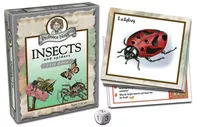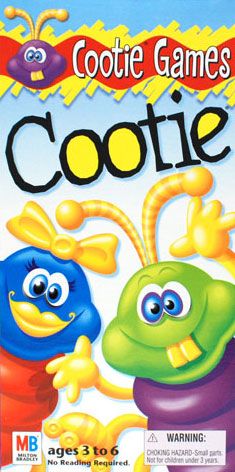Cootie (1927)
Speeltijd: 20
Min. Leeftijd: 3
Spelers: 2 - 4
Uitgever: Tyco, Russimco Games, MB Giochi, Peter Pan Playthings, Klee, Lemeco, MB Spellen, Toltoys, Chad Valley Co Ltd., Rorks, Michael Stanfield, Universal Publications Ltd, Brimtoy, Playskool, ER Juguetes, Vallbo, Hasbro, Milton Bradley, Gazebo Games UK Ltd., Zodiac Toys, Transogram, H. P. Gibson & Sons, Pilot Plastics, E. S. Lowe Company Inc., AMIGO, Drivabolagen AB, MB Jeux, Merit, Gibsons, Direco AB, MB Spiele, Basic Fun, Inc., Schaper, Köhler, House of Marbles, King International
Ontwerpers: William Schaper, J. H. W.
Kunstenaars: Onbekend
Mechanismen: Set Collection, Dice Rolling, Paper-and-Pencil
Min. Leeftijd: 3
Spelers: 2 - 4
Uitgever: Tyco, Russimco Games, MB Giochi, Peter Pan Playthings, Klee, Lemeco, MB Spellen, Toltoys, Chad Valley Co Ltd., Rorks, Michael Stanfield, Universal Publications Ltd, Brimtoy, Playskool, ER Juguetes, Vallbo, Hasbro, Milton Bradley, Gazebo Games UK Ltd., Zodiac Toys, Transogram, H. P. Gibson & Sons, Pilot Plastics, E. S. Lowe Company Inc., AMIGO, Drivabolagen AB, MB Jeux, Merit, Gibsons, Direco AB, MB Spiele, Basic Fun, Inc., Schaper, Köhler, House of Marbles, King International
Ontwerpers: William Schaper, J. H. W.
Kunstenaars: Onbekend
Mechanismen: Set Collection, Dice Rolling, Paper-and-Pencil
Beschrijving Tonen Opmerkingen Tonen Prijstrend
Players race to construct a plastic bug, rolling a die to see which piece they get to add.
The Hennepin History Museum states that the first Cootie game was designed by William H. Schaper in 1949. However, Schaper's game was not the first based upon the insect known as the "cootie". The creature was the subject of several tabletop games, mostly pencil and paper games, in the decades of the twentieth century following World War I.
In 1927, the J. H. Warder Company of Chicago released Tu-Tee, and the Charles Bowlby Company released Cootie; though based on a "build a bug" concept similar to Schaper's, both were paper and pencil games.
Schaper's game was the first to employ a fully three dimensional, free-standing plastic cootie.
Known in Australia as Creepy Critters and in the UK as Beetle Drive.
The Hennepin History Museum states that the first Cootie game was designed by William H. Schaper in 1949. However, Schaper's game was not the first based upon the insect known as the "cootie". The creature was the subject of several tabletop games, mostly pencil and paper games, in the decades of the twentieth century following World War I.
In 1927, the J. H. Warder Company of Chicago released Tu-Tee, and the Charles Bowlby Company released Cootie; though based on a "build a bug" concept similar to Schaper's, both were paper and pencil games.
Schaper's game was the first to employ a fully three dimensional, free-standing plastic cootie.
Known in Australia as Creepy Critters and in the UK as Beetle Drive.
We hebben momenteel geen prijsgegevens voor dit spel.
Dit spel wordt momenteel niet verhandeld op de marktplaats:
Dit spel staat momenteel niet op de marktplaats. Als u het uwe wilt verkopen, voeg het dan toe aan de marktplaats.
Marktplaats
Het spel werd ook onder deze namen uitgebracht:
Mini Cootie ,
Beetle Drive ,
Scootie ,
Myrspelet ,
Lucky Ladybirds ,
Here is Mr. Beetle ,
Escarabajo ,
Pirate ,
Le Scarabée ,
Mio Piccolo Asino ,
The Beetle Game ,
Van Kop tot Staart ,
Build a Beetle ,
Rippel Tippel Käfergetrippel ,
Deluxe Cootie ,
Beetle ,
Mon Petit Âne ,
Family Beetle Game ,
Giant Cootie ,
Mein Kleiner Esel ,
Cootie Keychain Set ,
The New Game of Cootie ,
애벌레 쿠티벅 ,
Beetle Game ,
The Traditional Game of Beetle ,
Tu-Tee ,
Cootie ,
Creepy Critters ,
Hog Wild ,
Forma le Formiche ,
Käferspiel ,
Lusen
Gerelateerde Spellen
ag.gameitem.lastUpdated: 2025-06-07 13:18:39.588
















